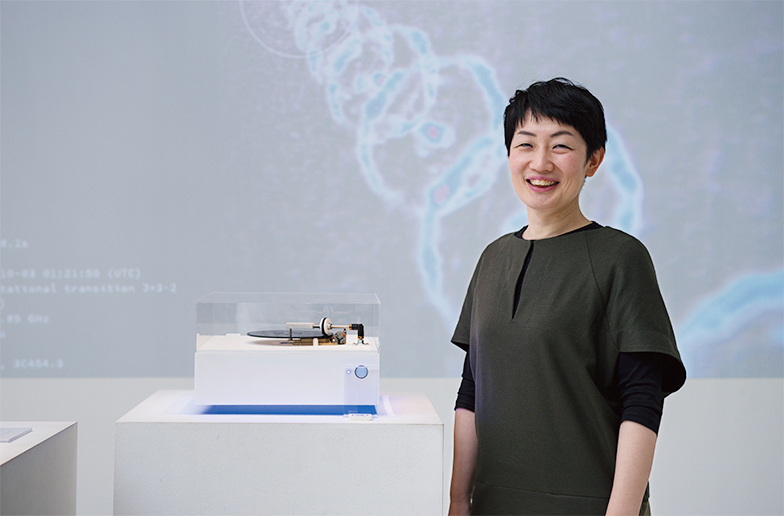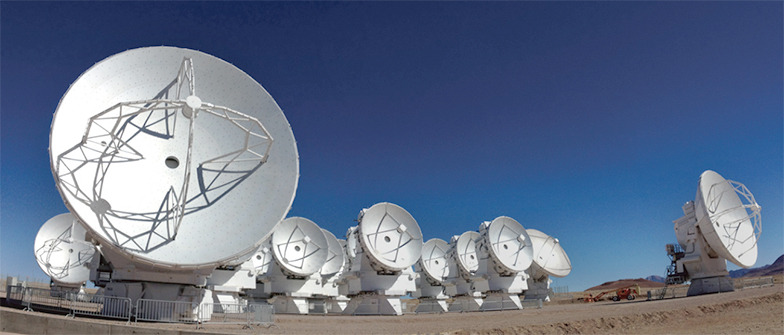Behind the Scenes of "Expressions That Reach"
We focus on and hear from "successful promoters of expressive activities" across various fields.
Interview with Sari Hayashiguchi, Representative of Epiphany Works
"What Emerges When Science Meets Creativity"

At the ALMA MUSIC BOX Exhibition Room (Kanazawa 21st Century Museum of Contemporary Art, "Our Time: Art in the Post-Industrial Society")
We are developing the "ALMA MUSIC BOX" project, which uses the power of creativity to expand the world of science. The theme is the ALMA telescope. It is the world's largest and most powerful radio telescope, jointly operated by 21 countries and regions. At an altitude of 5000 meters in Chile's Atacama Desert, 66 parabolic antennas are installed across a vast plain roughly the size of the inner loop of Tokyo's Yamanote Line. Observations began in 2013. Discoveries are anticipated that could overturn our understanding of the universe, our worldview, and our common sense – from the mysteries of galaxy formation to the search for the "building blocks" of life.
When I learned of this telescope's existence, I felt it was a shame that such incredible work was happening right nearby without people knowing. I wanted to share it with more people. But because it's a radio telescope, it doesn't produce beautiful images like the optical Hubble Space Telescope, making it difficult to convey. That's when I wondered: Could we use the data from this telescope's research to create works using the power of art, design, and creativity? This was the starting point for my "unsolicited proposal" to Dr. Masaaki Hiramatsu of the National Astronomical Observatory of Japan.

ALMA Telescope's Array of Parabolic Antennas ©ALMA (ESO/NAOJ/NRAO)
We commissioned Shinji Kawamura of PARTY New York. His final proposal was an idea no one else would have thought of: take the radio photographs visualizing the data, mark circles on the areas with the strongest radio signals, and turn them directly into music box discs. Seventy discs were created by automatically converting entire radio images of the swirling gas ejected from the star R Carinae, nearing the end of its life, using an algorithm. What was astonishing was that when you actually played these discs on a music box player, a beautiful melody emerged—as if the dying star itself were playing. Truly mysterious.
This music box disc has sparked a series of unexpected new collaborations. As an exhibition piece, it features an installation combining sound and visuals: barcodes on the discs, when scanned by a computer, display corresponding images. The 21st Century Museum of Contemporary Art, Kanazawa took notice and exhibited this work until mid-November.
Additionally, I planned a collaboration between sounds from space and 11 groups of musicians. We produced a CD through crowdfunding, released at the end of September. Perhaps because the musicians approached the challenge through the lens of how to engage with the melody received from a dying star, it truly felt like a collaboration created with that dying star. Diverse songs emerged, pleasantly defying expectations. Next September, we plan a concert featuring these CD tracks performed with the Kyoto Symphony Orchestra. We're also collaborating with the manga "Space Brothers." We've produced four music videos combining scenes from the manga with the CD's music, releasing them periodically.
This project seems to hold space for the creativity of many different people. There are so many elements that spark the imagination: "space," "the ALMA telescope," "a dying star." We're surprised ourselves that it hasn't wrapped up yet.
We've undertaken many projects like this, bridging different fields such as "Science × Creative." It's like being a translator between different languages. It's never been easy, but after great effort to connect the gaps, when people from fields with no prior connection meet, something far exceeding our expectations is born. That, to me, is innovation. I feel immense potential in cross-genre co-creation. Moving forward, we aim to continue pursuing activities that generate previously unnoticed perspectives and new values that steer society in a positive direction, collaborating with people from diverse genres.





